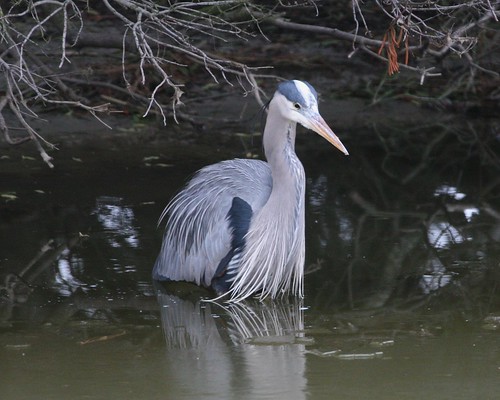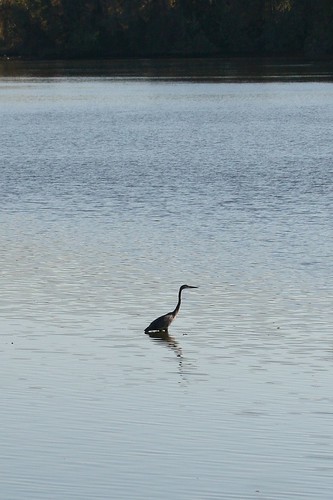I am taking a break from the Alaska photos this week to share a picture or two that I took this past weekend at Dutch Gap Conservation Area (DGCA). Nothing fancy, but it will take a little less time on my part during a week that has a lot less time available for blogging.
DGCA built a bridge this past winter that turned an eight mile out and back into a five mile loop. The weather was really nice this past Saturday, so Tammy and I went out and hiked the new loop. Along the way we found this Great Blue Heron posing ever so nicely next to the far shore.
Showing posts with label Great Blue Heron. Show all posts
Showing posts with label Great Blue Heron. Show all posts
Great White Heron
Back in January, Tammy and I were in south Florida for some college football, but also took some time to explore a bit. As my recent posts have described, we took one day to explore some of Everglades National Park. Another day trip, however was a drive south further down into the keys. One stop that we made on that drive was at the Florida Keys Wild Bird Center (FKWBC), located in Tavernier. Their primary purpose is to provide emergency and recuperative care for injured birds.
While exploring the FKWBC grounds I snapped photos of several of the injured birds, as well as several wild birds that were just hanging about the place. It wasn't until later, however, when I got a chance to review the photos, that I realized one of the large, white wading birds was not the Great Egret that I assumed it was. After flipping through several field guides, and doing some research on the Internet, I came to the conclusion that I had gotten a picture of a white morph Great Blue Heron (also known as Great White Heron).
The first field mark that my research pointed out was the color of the legs. Great Egret has black legs and Great White Heron has pale legs. Depending on the light, however, black legs might appear to be not quite black, but they are still much darker than the Great White Heron's pale legs. Next was the bill. The Great White Heron has a heavier bill than the Great Egret. To me, the Great White Heron looked like it had a regular Great Blue Heron's bill stuck on a white bird. Finally, the Great Egret may also have plumes trailing from its back and breast, while the Great White Heron would only have plumes trailing from its head. I suspect that there are other clues to help tell these two apart which I have not listed here.
Here are my photos. The first is the Great White Heron. The second is the Great Egret.
While exploring the FKWBC grounds I snapped photos of several of the injured birds, as well as several wild birds that were just hanging about the place. It wasn't until later, however, when I got a chance to review the photos, that I realized one of the large, white wading birds was not the Great Egret that I assumed it was. After flipping through several field guides, and doing some research on the Internet, I came to the conclusion that I had gotten a picture of a white morph Great Blue Heron (also known as Great White Heron).
The first field mark that my research pointed out was the color of the legs. Great Egret has black legs and Great White Heron has pale legs. Depending on the light, however, black legs might appear to be not quite black, but they are still much darker than the Great White Heron's pale legs. Next was the bill. The Great White Heron has a heavier bill than the Great Egret. To me, the Great White Heron looked like it had a regular Great Blue Heron's bill stuck on a white bird. Finally, the Great Egret may also have plumes trailing from its back and breast, while the Great White Heron would only have plumes trailing from its head. I suspect that there are other clues to help tell these two apart which I have not listed here.
Here are my photos. The first is the Great White Heron. The second is the Great Egret.
Great Blue Heron
Great Blue Herons are pretty common birds. I can find them year round in Virginia, so seeing them in Florida is never really a priority. But they are such good subjects for photography. They are large, so you don't have to worry much about being too far away. And, they are usually very still or slow moving, so you don't have to fight to keep them in frame or focus.
I like this photo of a Great Blue Heron. He looks a bit wind blown, and that yellow eye makes him look a bit grumpy.
I like this photo of a Great Blue Heron. He looks a bit wind blown, and that yellow eye makes him look a bit grumpy.
I think I said it was cold
A few posts back, when I described the trip to Chincoteague, I think I said it was cold. If I didn't, then let me correct that misunderstanding. It was cold. And when the wind blew, it was a type of cold that requires the use of profanity to describe. Here are a few miscellaneous photos that include ice, just as a guide of the coldness of it all.
The first picture is of a piece of wood or stump that was sticking up out of the water. The wind was blowing hard enough to send a sheet of ice from one end of the pond to the other. When the ice encountered the piece of wood, the ice was thin enough for the wood to carve right through it, leaving that trail of broken ice to the right of the stump.

This picture shows a group of Tundra Swan trying to get to the other side of a sheet of ice. One of the group just took flight and flew over. These, however, decided it would be easier to climb up and walk over the ice.

Finally, here is a shot of what I presume to be a very cold Great Blue Heron. To be more precise: I do not presume that this is a Great Blue Heron, but I do presume he is cold. He is standing up to his feathers in water, right next to a section that is frozen on top. It is almost like a Great Blue Heron Popsicle.

The first picture is of a piece of wood or stump that was sticking up out of the water. The wind was blowing hard enough to send a sheet of ice from one end of the pond to the other. When the ice encountered the piece of wood, the ice was thin enough for the wood to carve right through it, leaving that trail of broken ice to the right of the stump.

This picture shows a group of Tundra Swan trying to get to the other side of a sheet of ice. One of the group just took flight and flew over. These, however, decided it would be easier to climb up and walk over the ice.

Finally, here is a shot of what I presume to be a very cold Great Blue Heron. To be more precise: I do not presume that this is a Great Blue Heron, but I do presume he is cold. He is standing up to his feathers in water, right next to a section that is frozen on top. It is almost like a Great Blue Heron Popsicle.

Great Blue Heron
This is a Great Blue Heron. My friend Rich once told me that if you grabbed one by the bill, it would become very docile and could then be worn over your shoulders in the event you were chilly. Rich is never chilly.
Subscribe to:
Posts (Atom)




